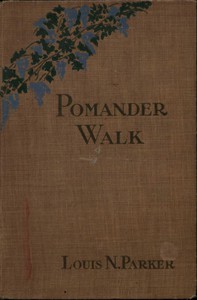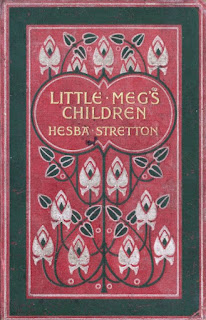Varför inte, förresten?
Bokens omslag i kombination med dess första meningar, kan göra mig rejält nyfiken. Som ”Pomander Walk”, av Louis N. Parker, omslaget är inte det tjusigaste jag sett, men det fångade mitt intresse, och när jag läst det inledande stycket bestämde jag mig för att titta närmare på boken. Det var mangeln som väckte min nyfikenhet — men än vet jag inte vad jag tycker om boken.
”It lies out Chiswick way, not far from Horace Walpole's house where later Miss Pinkerton conducted her Academy for Young Ladies. It is still there, although it was actually built in 1710; but London has gradually stretched its tentacles towards it, and they will soon absorb it. Where Marjolaine and Jack made love, there will be a row of blatant shops, and Sir Peter's house will be replaced by a flaring gin-palace. It has fallen from its high estate nowadays; and Mrs. Poskett's prophecy has come true: one of its dainty houses—I think it is the one in which the Misses Pennymint lived—is now indeed occupied by a person who earns a precarious living with a mangle.”
Uttrycket att inte döma boken efter omslaget lär ha förekommit i tryck första gången 1860 i George Eliots bok ” The Mill on the Floss”:
‘The History of the Devil’ by Daniel Defoe; not quite the right book for a little girl,” said Mr. Riley, “How came it among your books, Tulliver?”
Maggie looked hurt and discouraged, while her father said, “Why, it’s one o’ the books I bought at Partridge’s sale. They was all bound alike, it’s a good binding, you see, and I thought they’d be all good books. There’s Jeremy Taylor’s ‘Holy Living and Dying’ among ’em ; I read in it often of a Sunday.” (Mr. Tulliver felt somehow a familiarity with that great writer because his name was Jeremy); “and there ‘s a lot more of ’em, sermons mostly, I think ; but they ‘ve all got the same covers, and I thought they were all o’ one sample, as you may say. But it seems one mustn’t judge by th’ outside. This is a puzzlin’ world.
Då har ”Little Meg's Children” från 1905 av Hesba Stretton ett tjusigare, tidsenligt, omslag.
Jag har läst tillräckligt många av Hesba Strettons böcker för att veta att de har ett oförvitligt och uppbyggligt kristet innehåll. De utspelar sig ofta i slummen, är föräldrarna inte alkoholiserade så är de döda — båda delarna vanliga på den tiden.
Även om moralen kan bli i mesta laget så visste författaren hur man skulle fånga sina läsare, och hon var omåttligt populär på sin tid.
”In the East End of London, more than a mile from St Paul's Cathedral, and lying near to the docks, there is a tangled knot of narrow streets and lanes, crossing and running into one another, with blind alleys and courts leading out of them, and low arched passages, and dark gullies, and unsuspected slums, hiding away at the back of the narrowest streets; forming altogether such a labyrinth of roads and dwellings, that one needs a guide to thread a way among them, as upon pathless solitudes or deserts of shifting sands.”





Inga kommentarer:
Skicka en kommentar